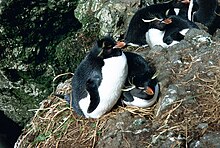Eastern rockhopper penguin: Difference between revisions
Lower case for species common name as described at Wikipedia talk:Manual of Style/Archive 156#Bird common name decapitalisation. |
Serenawong15 (talk | contribs) No edit summary |
||
| Line 27: | Line 27: | ||
==References== |
==References== |
||
{{reflist}} |
{{reflist}} |
||
==Further Reading== |
|||
{{cite journal|last1=Morrison|first1=K.W|last2=Battley|first2=P.F|last3=Sagar|first3=P.M|title=Population dynamics of Eastern Rockhopper Penguins on Campbell Island in relation to sea surface temperature 1942-2012: current warming hiatus pauses a long-term decline|journal=Biodiversity Conservation|date=February 2015|volume=38|issue=2|page=163-177|doi=10.1007/s00300-014-1575-x}} |
|||
[[Category:Eudyptes]] |
[[Category:Eudyptes]] |
||
Revision as of 18:39, 27 April 2015
| Eastern rockhopper penguin | |
|---|---|

| |
| Scientific classification | |
| Kingdom: | |
| Phylum: | |
| Class: | |
| Order: | |
| Family: | |
| Genus: | |
| Species: | E. chrysocome
|
| Trinomial name | |
| Eudyptes chrysocome filholi Hutton, 1878
| |
| Synonyms | |
|
Eudyptes filholi | |
The eastern rockhopper penguin (Eudyptes chrysocome filholi) although genetically different[1][2] is still often considered a subspecies of the southern rockhopper penguin.
Taxonomy
The rockhopper penguin Eudyptes chrysocome is sometimes considered two species, northern and southern rockhopper penguin, after research published in 2006 demonstrated morphological, vocal and genetic differences between the two populations.[3][4] Molecular datings suggest that the genetic divergence with the southern rockhopper penguin may have been caused by a vicariant event caused by a shift in the position of the Subtropical Front during the mid-Pleistocene climate transition.[5] Analysis of a part of a mitochondrial control region from a northern rockhopper penguin found on the Kerguelen Islands showed that it may have come from Gough Island, 6,000 km away, and that the southern and northern rockhoppers are genetically separate, though some individuals may disperse from their breeding colonies.[6] Many taxonomists have yet to recognize the split, although some are beginning to do so.
Distribution
E. c. filholi breeds on the sub-Antarctic islands of the Indo-Pacific Ocean: Prince Edward, Crozet, Kerguelen, Heard, Macquarie, Campbell, Auckland, and the Antipodes Islands.
References
- ^ Jonathan Banks, Amy Van Buren, Yves Cherel & James B. Whitfield (2006). "Genetic evidence for three species of Rockhopper Penguins, Eudyptes chrysocome". Polar Biology. 30 (1): 61–67. doi:10.1007/s00300-006-0160-3.
{{cite journal}}: CS1 maint: multiple names: authors list (link) - ^ Marc de Dinechin, Richard Ottvall, Petra Quillfeldt & Pierre Jouventin (2009). "Speciation chronology of rockhopper penguins inferred from molecular, geological and palaeoceanographic data". Journal of Biogeography. 36 (4): 693–702. doi:10.1111/j.1365-2699.2008.02014.x.
{{cite journal}}: CS1 maint: multiple names: authors list (link) - ^ Jouventin P., Cuthbert R.J., Ottvall R. (2006). Genetic isolation and divergence in sexual traits: evidence for the Northern Rockhopper Penguin Eudyptes moseleyi being a sibling species. Molecular Ecology 15:3413-3423.
- ^ Banks J., Van Buren A., Cherel Y., Whitfield J.B. (2006). Genetic evidence for three species of Rockhopper Penguins, Eudyptes chrysocome. Polar Biology 30:61-67.
- ^ de Dinechin, M., Ottvall R., Quillfeldt P. & Jouventin P. (2009). Speciation chronology of northern rockhopper penguins inferred from molecular, geological and palaeoceanographic data. Journal of Biogeography 36(4):693–702.
- ^ de Dinechin M., Pincemy G., Jouventin P. (2007) A northern rockhopper penguin unveils dispersion pathways in the Southern Ocean Polar Biology. 31(1):113-115
Further Reading
Morrison, K.W; Battley, P.F; Sagar, P.M (February 2015). "Population dynamics of Eastern Rockhopper Penguins on Campbell Island in relation to sea surface temperature 1942-2012: current warming hiatus pauses a long-term decline". Biodiversity Conservation. 38 (2): 163-177. doi:10.1007/s00300-014-1575-x.
- Eudyptes
- Penguins
- Flightless birds
- IUCN Red List endangered species
- Birds of Australia
- Birds of New Zealand
- Vulnerable fauna of Australia
- Animals described in 1878
- Fauna of the Crozet Islands
- Fauna of the Prince Edward Islands
- Fauna of Macquarie Island
- Fauna of Campbell Island, New Zealand
- Fauna of Heard Island and McDonald Islands
